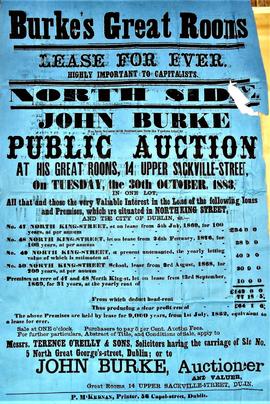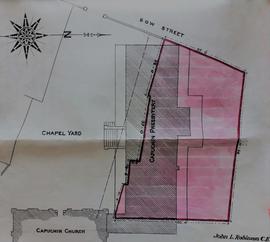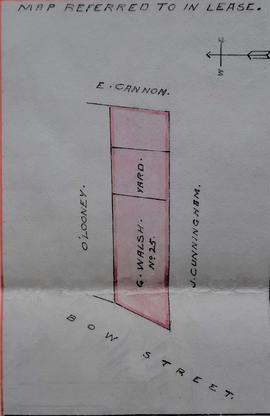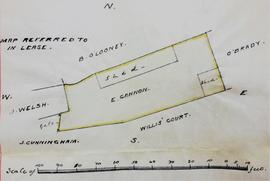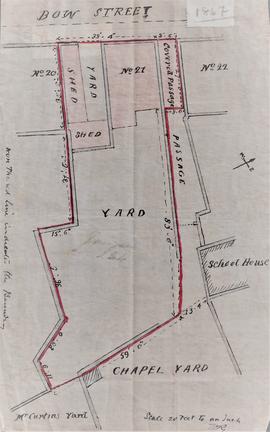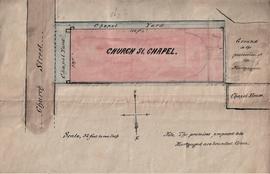Identity area
Reference code
Title
Date(s)
- 1685-2014 (Creation)
Level of description
Extent and medium
18 boxes, comprising 307 files and 133 items
Context area
Name of creator
Repository
Archival history
Immediate source of acquisition or transfer
Content and structure area
Scope and content
Church Street, one of the oldest thoroughfares on the north side of Dublin, has long been identified with the Capuchin Franciscans. For many years the friars have been known as the ‘Church Street Fathers’. Yet Church Street was not the location of their first residence in Dublin. The first Capuchin friars arrived in Dublin in 1615. At first, they settled on the south side of the city near Thomas Street, before moving to Bridge Street in about 1632, and later still to a house not far from Saint Audeon’s Arch. Fr. Christopher Kearney OSFC (d. 1656), in remarks on the progress of the Irish Capuchin mission, explained how ‘in the beginning, from the year 1615 to 1624, when they were very few, the friars lived in ones and twos in the houses of other people, not as a regular community; but then as numbers increased they established communities … in buildings either newly erected, or rented, and adapted for religious use and as chapels in which they maintained regular observance until the year 1651’. Fr. Edward Bath OSFC (d. 1634) was appointed the superior of the first Capuchin house in Dublin. Fr. Robert O’Connell OSFC (c.1623-1678) in his 'Historia Missionis Hiberniae Fratrum Minorum Capucinorum' (c.1654) described the first residence of the friars as small and poor, consisting of a few cells, a little garden, and a small chapel. Fr. Christopher Kearney OSFC remarked that ‘some of the Capuchins went among the people, at other times people flocked to the Capuchins at home. They were accustomed to preach in both English and Irish. … In their own churches, and when preaching elsewhere, they were zealous in opposing heretics and in comforting Catholics by the administration of the sacraments’. In 1629 the first residence of the friars in Dublin was confiscated with the house handed over to Trinity College. It was converted into a residential hall and given the name ‘St. Stephen’s Hall’.
The friars were dispersed and for a time they continued their work in the countryside until securing a small rented house in 1632. Fr. Nicholas Archbold OSFC (1589-1650) in his 'Historie of the Irish Capucins' (1643) confirms that by 1642 the Capuchins were resident on Bridge Street in a ‘secular man’s house and mansion: wee had the forpart of it: which stood on the street’. At this time the ‘religious and priests enjoyed peaceably the publick use of their chapells’ and the Capuchins had use of a well-furnished chapel in which they celebrated Mass every day in the religious habit. Soon afterwards, however, the authorities moved to seize churches and religious houses in Dublin, including that of the Capuchins – ‘entering violently in the Chapells they laid hands on all they could find, subverted the Altars, tore and broke and trampled under foot and burnt the sacred pictures and turned ye Chappels into Courts of Guard’. After the destruction of their house and the exile of many priests, the remaining friars ministered in the countryside until they had an opportunity of returning to Dublin. However, the prospects for re-establishing regular community life seemed remote. In June 1653 an edict was passed reviving the Elizabethan statute proscribing the exercise of the Catholic religion and ordering the exile of all priests. As a consequence, for many years, there was no trace of any settled community life for the Capuchins in Dublin.
Individual friars continued to be engaged (albeit furtively) in ministry in Dublin. There are indications in 1667 that a Capuchin chapel existed in the city. Lady Ursula Moore, in her will dated 2 October 1667, bequeathed a silver chalice to her son Thomas Whyte, a Capuchin friar, and arranged that the interest on a sum of money ‘shall pay the rent of the Capucins’ Chappell in Dublin’. In 1671 Fr. Luke Nugent OSFC, Commissary General, reported that the Capuchins had re-established a hospice in Dublin but no indication was given as to the site of their restored residence in the city. With the accession of King James II in 1685 religious liberties were restored to Catholics and churches were repaired and rebuilt. In about 1689 the Capuchins built what must have been a fairly substantial residence near Saint Audeon’s Arch. The friary had a community of twenty-four religious who led a full conventual life as well as engaging in active ministry. The Capuchins resided in this house for only two years before it was suppressed in the wake of the Williamite victory in the 1690s. Up to this period the Capuchins had been living on the south side of the River Liffey. A report written by Fr. Lawrence Dowdall OSFC in 1701 suggests that after the suppression of the friary near Saint Audeon’s Arch, the friars ministered in a ‘rented chapel’. There is evidence to suggest that this chapel was situated on Church Street. Information sworn by a Margaret Meehan on 3 May 1691 against Fr. Innocent Weldon OSFC (d. 1707) for being a Popish priest states ‘we heard him preach in ye Popish Masshouses in Church Street and on Channel Row [later North Brunswick Street]’. In 1697 it was noted that Fr. Lawrence Dowdall OSFC was ‘lodgeing att Matthais Burgesses in Church Street’. It seems certain that the Capuchins settled in Church Street soon after their residence near Saint Audeon’s Arch was suppressed.
'A Report of the Roman Catholic Chapels in Dublin' (1749) noted that the Church Street Chapel ‘was fitted up in the year 1720, for the use of the Capuchin friars (who in the reign of King James II lived at St. Audeon’s Arch) by Father Joseph Evers, Superior of the Order’. It was also claimed that this chapel was located in the house of a Mr. Clements. This reference to a Mr. Clements is of particular importance as it suggests that the chapel that existed in 1720 occupied the same site as the present-day Church of St. Mary of the Angels. In the lease of the site of St. Mary of the Angels made on 4 August 1826 by the Earl of Longford and Viscount de Vesci to Fr. Bonaventure Delaney OSFC (d. 1841), it is mentioned that the property being leased had formerly been in the possession of James Topham and later in the tenancy of Robert Clements ‘on which a Roman Catholic Chapel had been built’. (see CA CS/2/2/1/2). The chapel referred to in the lease is an older building as the present-day St. Mary of the Angels had not been built in 1826. The site of this original Capuchin chapel on Church Street was Roscommon House which stood on the street to the front of the modern-day church. This first chapel was extensively repaired in 1736 by Fr. Alexius Dowdall OSFC (d. 1738). It was described in 1749 ‘as small and neat and the altar decent. The altarpiece is a Crucifixion, though formerly it was a painting of our Saviour taken down from the Cross. … There is a gallery which serves as a choir with a vestry but no confessionals’. This original chapel was taken down in 1796 and a slightly larger one was built on the same site (see CA CS/7/1). In 1831 it was remarked that the ‘Church Street chapel is situated on the west side of the street and not far from St. Michan’s [Anglican] Church … the building itself offers no remarkable features. This structure was for a long period in a state of dilapidation until the manly eloquence of Rev. [Michael Bernard] Keogh [1788-1831], a friar of the Capuchin Order, influenced the wealthy part of his hearers … to contribute largely to the restoration of this edifice’. The fact that this chapel was extensively damaged by the Great Storm of January 1839 (also known as the ‘Night of the Big Wind’) may have given additional impetus to build a new church. At any rate, it was clear that the friars were finding their chapel inadequate and were considering building a larger church as well as a friary for the religious.
The foundation stone of the present-day St. Mary of the Angels was laid by Archbishop Paul Cullen in 1868. (see CA CS/7/2). The church was built in sections, the sanctuary being built first. A significant portion of the church was built by direct labour, without a contractor, but with a clerk of works supervising the tradesmen in carrying out the instructions of the architect, James Joseph McCarthy (1817-1882). A contracting firm was later employed to complete the undertaking. This, together with the lack of funds, probably explains why the construction work took so long. The façade was not completed until 1882. The church was solemnly dedicated by Cardinal Edward McCabe on 4 October 1882. While all this was in progress, more ground space became available which allowed for the building of a new friary at the rear of St. Mary of the Angels. Although plans for the friary were drawn up as early as 1875, the building was not finished until 1883. The Capuchin community subsequently left their residences on North King Street and moved to the purpose-built friary on Church Street where they have remained ever since.
Collection Content
The fonds consists of records relating to the Capuchin community in Dublin and in particular to the foundation known as St. Mary of the Angels situated on Church Street. The fonds includes legal records relating to the acquisition, transfer and disposal of church property (such as deeds of title, mortgages and bills of sale), financial records, and material relating to individual members of Capuchin communities in Dublin. The collection includes a large number of administrative and community files, financial statements and books of account relating to building construction and structural alterations, correspondence, plans, publicity material, photographs, and miscellaneous items of commemorative ephemera connected with Capuchin ministries and apostolates in Dublin. The collection also includes unpublished historical writings and biographical material relating to notable members of the Capuchin Order who ministered in Dublin. The fonds also includes records relating to the lay religious sodality known as the Third Order of St. Francis (now the Secular Franciscan Order) attached to the Capuchin church in the city.
Appraisal, destruction and scheduling
Accruals
System of arrangement
The material has been catalogued (2018) and a new arrangement has been imposed upon the fonds. The collection has been divided into eight series, of which four have been further divided into sub-series. Due to the large extent of papers, one sub-series including deeds related to properties on Church Street has required a further division into sub-sub-series. The papers in each of the series represent either a particular area of activity, a subject or a specific document or record type and have been arranged accordingly. Within the various divisions all the papers have been arranged chronologically.
Conditions of access and use area
Conditions governing access
Access is open to bona fide researchers. Records containing personal information are subject to access restrictions.
Conditions governing reproduction
Language of material
- English
- Latin
Script of material
Language and script notes
Physical characteristics and technical requirements
The papers are generally in good condition
Finding aids
Descriptive catalogue
Allied materials area
Existence and location of originals
Existence and location of copies
Related units of description
Notes area
Alternative identifier(s)
Access points
Subject access points
Place access points
Name access points
Genre access points
Description control area
Description identifier
Institution identifier
Rules and/or conventions used
Status
Level of detail
Dates of creation revision deletion
Language(s)
- English

